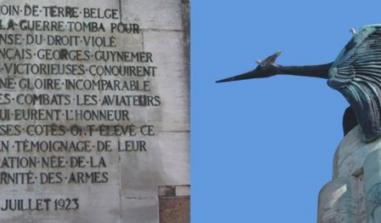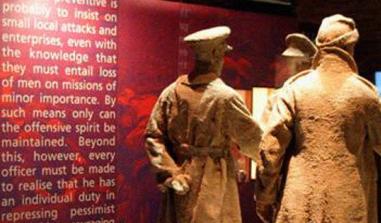The fortified town of Binche
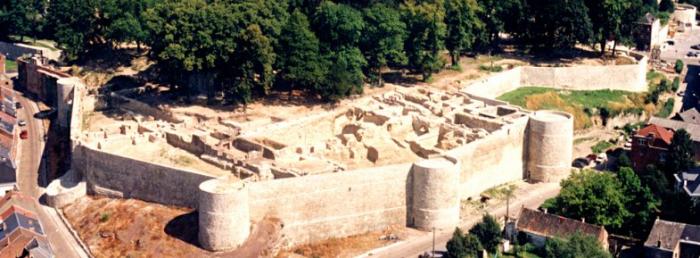
The fortified town of Binche. Photo of the town of Binche.
The fortified town of Binche, dubbed the 'Carcassonne’ of Wallonia.
With its stone wall surmounting an immense earthen embankment stretching 2.5 kilometres and its 25 towers, Binche boasts a monumental ensemble unique in Belgium. In fact, it is the only medieval surrounding wall that has been almost entirely preserved in the whole country. It is no exaggeration to call it the Carcassonne of Wallonia! Only the gates, five towers and some three hundred metres of wall sections have disappeared over the years. The site represents over three centuries of military architecture.
Originally, Binche was a simple dependency in the parish of Waudrez, the Roman site of Vodgoriacum. Founded in the 12th century, the town was awarded the status of new town in 1120. Instead of a keep, the Count of Hainaut surrounded the residential districts set in the far south of a spur encircled by the small river Samme (also called the Princess) with a stone wall. The town of Binche already participated in the county's defence from the 12th century. This was supported as much by strongholds owned by the count and managed by a feudal lord (in Binche, he is mentioned as far back as 1138) as well as châteaux belonging to vassals. The network of fortresses formed a strategic chessboard. An agricultural centre, the town quickly became a thriving producer of woolen fabric. A deanship was also established there.
A first stone wall was erected in the 12th century to block the rather wide access via the spur. This example seems early for the Lotharingian principalities where earth and wood were still the preferred materials for urban walls. There are only a few remaining traces near the château and the Posty rampart. The north front has completely disappeared. The historians place it at the top of Rue de la Gaité.
From the first findings of the digs conducted since 1996 in the château grounds by Wallonia’s archaeological department, the count had built in the 12th century a vast fortified palace of which the ruins of the hall, the lecture hall and the chapel were unearthed at the far south of the spur. The fortifications were built over a long period and adapted systematically to the advances made in defensive architecture and armaments: from the late 14th century, new architectural forms acknoweldged power-fired artillery, which was used in the West from around 1320.
In Binche, there is no indication that the large surrounding wall built from the 14th century was initially adapted to this new type of weaponry. The new towers were very prominent and equipped with an intermediate level of defence. The value of the new walls came from the way they were constructed, their foundation laid on archways, which provides stability and saves on materials, seeing as how the subsoil, with the exception of the south section, was unstable and marshy in parts. This system was practised in many other towns in the former Netherlands (Lille, Valenciennes, Brussels, Bruges, Namur, etc.).
In the late 14th century, the master builders for the Count of Hainaut, Thomas Ladart, born in Ath, and Noël Camp from Avaine, led a campaign to modernise the surrounding wall. New towers, inhabitable and fitted with openings (windows and arrowslits) were added to the wall. In the early 15th century, in Hainaut, which was neutral but caught between Burdundy, France and Liège, it became important to arm and reinforce the garrison and the ramparts. Binche acted as a hub, as it did, for example, during the operations against the principality of Liège from 1406 to 1408.
Later, once under Burgundy control, Binche was one fortress among others. Gunboats were installed in the curtain walls of the old cemetery. The small tower was built there and equipped with gunboats for artillery fire. Until the mid-16th century, despite the progress made with artillery and fortifications, Binche was part of the defensive strategy of Hainaut and the Netherlands, at least as a centre for the assembling of the imperial troops, as testified by two sieges, in 1543 and 1554. However, the siege of 1578 rendered the urban defences definitively obsolete, commanded as they were from the neighbouring heights.
From the old Brunehaut road leading to Maubeuge, you can see the top of the belltower of the collegiate church, the rest of the town being hidden by the drop in terrain. Numerous cannonball strikes had been hastily patched over in the southern section: areas filled with brick and the addition of decorative architectural features (pink sandstone in the ramparts and gothic vaults) are still visible.
The sumptuous Renaissance palace built by the Mont-de-Marsan architect Jacques Du Broeucq for the regent Mary of Hungary, on the foundations of the medieval castle, was a magnificent target for the French cannons. Burned down in 1553, it was permanently reduce to ruins in 1578. Under Archdukes Albert and Isabella (1599-1621) a restoration was attempted but failed to reach completion. A number of sculpted pieces were sent to Mons (such as the entrance gate) or were reused in Binche itself.
In the 17th century, Binche served occasionally as a logistics unit or a parade ground for marching armies. Beforehand, the town was seized twice by the French: in two days during 1643, then by Turenne in 1654. In 1668, it was ceded to France for ten years. During the campaign of 1672-1674 led by Louis XIV, it served as a post for the army of the field. While fortifications were built during this time, by the early 18th century, the surrounding wall was unusable: there were breaches in the curtain walls and the towers were razed to the ground. This all put an end to Binche’s military role. The border was pushed north but the defence of the region was provided by the Toumai-Mons-Charleroi line.
In the 19th century, the town lost its fortified gates and the wall was little by little enclosed by individual properties. In 1995, a vast restoration campaign was started in Binche and digs were conducted with the help of the European Community and the Region of Wallonia, as part of the Objectif 1 programme. These far-reaching works led by Wallonia's archaeological department between 1995 and 1999, precisely revealed the evolution of the ramparts and the chateaux in the town.
Binche Tourist Information Office
Grand-Place
7130 Binche
Tel.: 064/33.67.27
Fax: 064/23.06.4
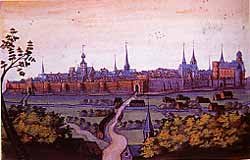
Town of Binche in the 16th century. Source: Album de Croÿ
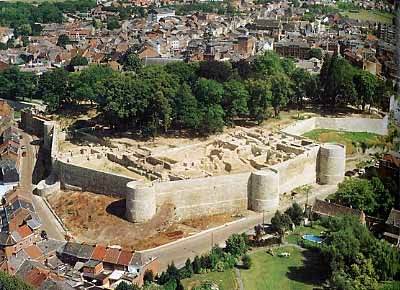
The fortified town of Binche. Photo of the town of Binche.
Practical information
7130
Binche
Accessibilité toute l'année


